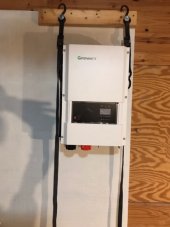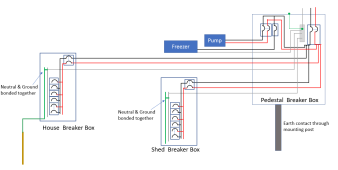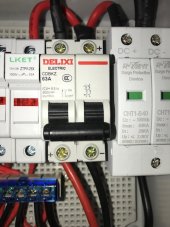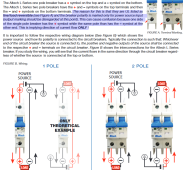Growatt spf6000dvm. The handles are nice and shiney, but why don't they manufacturer some kind of usefull handles into the chassis to ease the burden of hoisting this thing. Geez.
Not sure how the pros hang one of these low freq 100lb wall warts, but this is what I had available. Two motorcycle tie down straps, scrap 2x4, screws, and lag bolts.
So now it is mounted and the batteries should be in any day, I'm ready to start wiring but ... the growatt has grid assist which I think will come in handy on those pesky rainy weeks we get from time to time, but what about grounding and neutral from the shed breaker box? (pic of wiring below thanks to FilterGuy)
For the 240v from grid (shed breaker box), the GW wants two hots and a ground. Why not two hots and a neutral?
As pictured below, the shed breaker box has both neutral and ground bonded. How does this affect connection of the GW to the grid?
And what about the grounding screw on the GW chassis?
In relation to the pv panels, do the panels get grounded and that ground runs along with the home run from panels to the GW?
.


Not sure how the pros hang one of these low freq 100lb wall warts, but this is what I had available. Two motorcycle tie down straps, scrap 2x4, screws, and lag bolts.
So now it is mounted and the batteries should be in any day, I'm ready to start wiring but ... the growatt has grid assist which I think will come in handy on those pesky rainy weeks we get from time to time, but what about grounding and neutral from the shed breaker box? (pic of wiring below thanks to FilterGuy)
For the 240v from grid (shed breaker box), the GW wants two hots and a ground. Why not two hots and a neutral?
As pictured below, the shed breaker box has both neutral and ground bonded. How does this affect connection of the GW to the grid?
And what about the grounding screw on the GW chassis?
In relation to the pv panels, do the panels get grounded and that ground runs along with the home run from panels to the GW?
.







